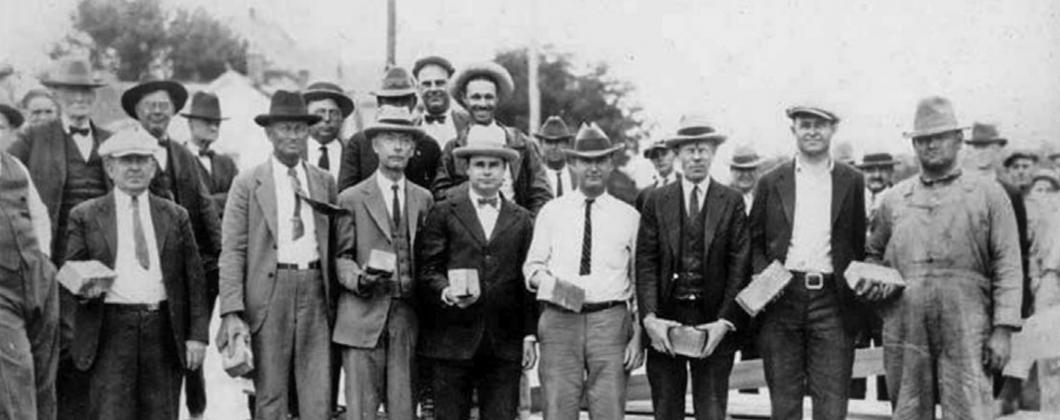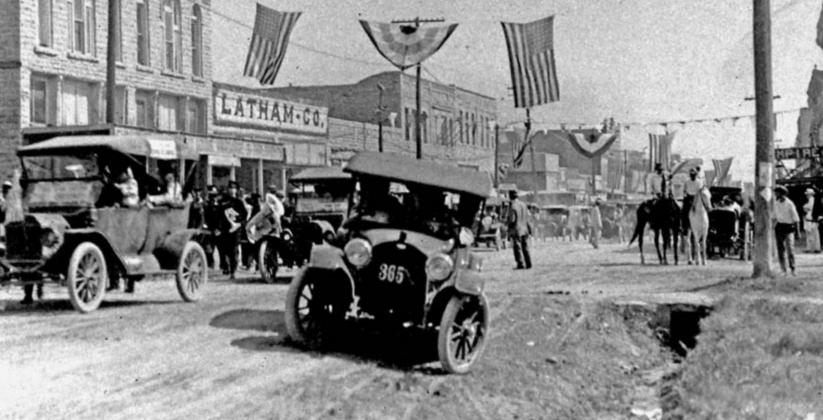It was in May of 1919 that Mayor Sheehan started taking an interest in paving the streets of Dublin. He had taken trips to Dallas, Austin, San Antonio and Cisco. While there, he talked to city commissioners about the benefits and the problems of paving city streets. When he came back, he said that the paving could be done readily and economically. “We should be making plans for this to take place.” (Dublin Progress May 16, 1919)
It took a while to work out all the details with creating the bonds and getting the railroads to agree to the work. At a later city council meeting, a motion was made and passed for issuing $40,000 in bonds to be voted on by citizens. The passing of the bond saved $150 per month since sprinkling to hold down dust and dirt would no longer be needed. That money would be used elsewhere in the city. (Dublin Progress, September 4, 1925)
There were some estimates of the immense amount of materials that would be needed for paving downtown. Because of the weight of the nine pound bricks, only 9000 bricks could be carried on a railroad flat car. It was estimated that 120 train cars of brick would be needed for the 1,000,000 brick estimated to complete the project. Ten train cars of asphalt would be needed, along with four or five cars of gravel and twenty car loads of sand. That did not include the immense amount of labor needed. (Dublin Progress, February 5, 1926)
Much of the paving brick were laid at one part of town and natural gas lines in another. The organization of the two projects moved along very well so that neither project got in the way of the other. The natural gas was to come come from Sip Springs and the pipe would be laid to De Leon, then onto Stephenville, Dublin, and Comanche. The supply of natural gas from the Sip Springs source was said to be almost inexhaustible. For the streets, the curbs and guttering between Blackjack Street and Live Oak had been completed and was ready for the paving.(Dublin Progress, April 16, 1926, June 11, 1926)
On Wednesday May 12, there was a ground breaking and dedication ceremony. There, the city councilmen laid the first bricks initiating the work for the paving to start. The councilman’s bricks were laid at the corner of Live Oak and Patrick Street. Experienced brick layers then moved in to continue the work so all could see what the paving brick would look like. The brick layers continued their work from Live Oak Street moving south toward Blackjack on Patrick Street. (Dublin Progress May 14, 1926)
The editor of the Dublin Progress wrote, “The first block of paving has just been complete and it looks wonderful. Just take a drive and see how nice the streets are in Dublin. They are as good or better than any other town around here.”
(Dublin Progress May 21, 1926)
The street paving continued rapidly. Material for the workers was arriving daily. Soon, six blocks were paved. The brick laying was continuing to the Evans Hotel on Blackjack Street. The gas lines were also being rushed to be in place so homes could be connected by winter. The gas was being provided by the Phillips and Fullerton company in Breckenridge. (Dublin Progress June 18, 1926)
People were so pleased with the brick downtown, that they wanted additional paving in the city. A newspaper article said that a bond election could be called for additional paving on north and south Patrick, east and west Blackjack Street, Elm Street and north Grafton. It was hoped that since Patrick and Blackjack streets were part of state highways, that the state might help with the cost.
(Dublin Progress, August 27, 1926)
It was also hoped that a bond could be passed for the additional $38000 needed to pave the residential streets. That included extending the paving north on Patrick to the gas station at the north end of the street. (possibly Camp Dublin where the
Dairy Queen is now.)
(Dublin Progress, September 3, 1926)
In a later issue of the newspaper, the headline read “City Will Vote On Paving Bonds October 5“ (Dublin Progress, September 24, 1926)
The election took place and the bond passed to pave an additional 2 miles on residential streets. It passed three to one assuring that the people in town were behind this measure. It was thought that the actual work would not take place for another two months. (Dublin Progress, October 8, 1926)
Many thanks to all the volunteers who keep the museum open. A special thank you to all who are hosting each afternoon. We have had a large number of people who have helped us over the years. I have a note on my bulletin board to say thank you to Marcel Gregory who helped Mary Yantis over the many years that Mary grew the museum and kept history alive in Dublin.


